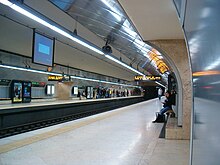Alameda Metro Station
Alameda is a metro station on the Linha Verde (green line) and Linha Vermelha (red line) of the Lisbon Metro , the subway network of the Portuguese capital . The station is located at the intersection of Avenida Almirante Reis / Alameda Dom Afonso Henriques and thus on the border between the municipalities of São Jorge de Arroios , Alto do Pina and São Jorge de Deus . The neighboring stations of the train station are Arroios , Areeiro , Saldanha and Olaias . The Linha Verde platform went into operation on June 18, 1972, and that of Linha Vermelha on May 19, 1998.
history
Construction of the first train station
The Alameda metro station went into operation on June 18, 1972 as part of the final extension ( Anjos - Alvalade ) of the first construction phase of the Lisbon metro. Within fifteen years, the city of Lisbon was able to connect all of the city's major centers using the new means of transport. With this extension , Alvalade was the last to have an underground connection.
The architect Dinis Gomes was responsible for the construction of the underground station, as was the case with the others in this construction phase, and he had designed a similar concept for all stations. When it opened, the station had two 70-meter-long side platforms and a flat, rounded platform ceiling, similar to the neighboring stations. Maria Keil was again responsible for the design of the station . She chose the tried and tested tiles ( azulejos ) with a white background and contrasted them with numerous stripes in various shades of green.
Conversion to a transfer station
Relatively little has changed at Alameda station over the years . Only with the adoption of the Plano de Expansão da Rede 1999 (plan to expand the network by 1999) in 1990 did the station come into focus again. The plan was to divide the existing Ypsilon network into three lines (blue, yellow and green) and to build a new line (red line). In 1998, the Pontinha - Restauradores - Rossio - Alameda - Campo Grande line, which was then operated as a continuous line, was divided into two lines; Pontinha - Restauradores as a blue line, the Rossio - Campo Grande route tangent to the Alameda as a green line. After Lisbon was able to prevail against Toronto in Canada in the 1998 World Exhibition , construction began on a new metro line. This line should initially run from Oriente station , located directly in the World Exhibition Park , to Alameda station , where there was a connection to the center via the green line.
As part of the construction of the new subway line, extensive construction work was also planned for the Alameda station . The Plano de Expansão da Rede 1999 also gives the artistic design a large framework, which should be a feature of the Lisbon subway network. Under the direction of the Portuguese architect Manuel Taínha , what will in future be called "Alameda I" , the station on the green line, was completely rebuilt. Among other things, the platforms were extended from 70 to 105 meters in order to be able to use six-car trains in the future. The artist Noronha da Costa supplemented Keil's tile art with various paintings on a marble background. The station on the green line was put back into operation on March 3, 1998 after being closed for several months.
The red line station ( "Alameda II" ) and the transfer tunnel were designed by Manuel Taínha and Alberto Barradas . The station on the red line has the two side platforms customary in Lisbon, but at the same time an oversized platform hall at the western and eastern ends, so as not to create a narrow space despite the depth of the platform, which was necessary due to the crossing of the green line. Costa Pinheiro , Alberto Carneiro and Juahana Bloomstedt were responsible for the artistic design . Pinheiro designed part of the transfer tunnel with tile motifs called Os Navegadores ("The Seafarers") and shows images of Portuguese personalities such as João II , Henry the Navigator (Infante D. Henrique), Vasco da Gama and Fernão de Magalhães . Carneiro, a so-called Land Art artist, chose several architectural sculptures that were supposed to give the underground station a touch of nature. The Finnish artist Bloomstedt designed numerous geometric figures in different marble tones.
Ultimately, the red line and with it the Alameda II station went into operation on May 19, 1998, three days before the opening of Expo 98 in what is now Parque das Nações . For eleven years, trains coming from Oriente ended at Alameda station , and a provisional sweeping system was set up in the tunnel to the west. From the beginning it was planned to extend the red line further west. In 2003, construction began on an extension of the Linha Vermelha via Saldanha to São Sebastião . As of August 29, 2009, Alameda is no longer a terminus. The trains now go through to São Sebastião .
course
At the underground station you can change to the Carris bus lines .
| line | course |
|---|---|
| Telheiras - Campo Grande - Alvalade - Roma - Areeiro - Alameda - Arroios - Anjos - Intendente - Martim Moniz - Rossio - Baixa-Chiado - Cais do Sodré | |
| Aeroporto - Encarnação - Moscavide - Oriente - Cabo Ruivo - Olivais - Chelas - Bela Vista - Olaias - Alameda - Saldanha - São Sebastião |
Individual evidence
- ↑ a b c d Information about the underground station. Metropolitano de Lisboa, EPE, accessed March 31, 2013 .
Web links
- Area map of the train station (PDF file, 380 KiB)
Coordinates: 38 ° 44 ′ 12.8 ″ N , 9 ° 8 ′ 1.5 ″ W.


